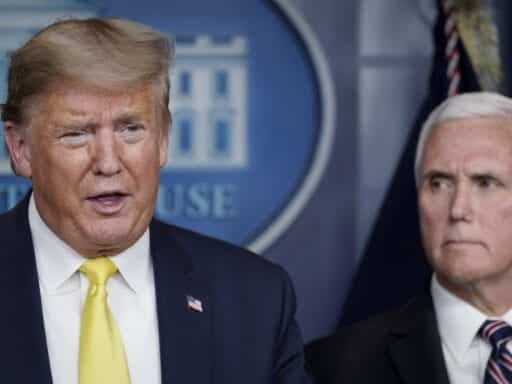The Trump administration has drawn criticism for its slow response to the novel coronavirus outbreak.
President Donald Trump responded to the worsening outbreak of the novel coronavirus by taking to Twitter Tuesday morning to lash out at the Federal Reserve, criticize former President Obama, and call for border walls.
Trump’s tweets come a day after he showed up at a White House coronavirus task force press conference and touted the administration’s response to the US outbreak, which has infected more than 750 people and killed at least 27, singling out closing the borders to travelers from affected areas. He also previewed the White House’s proposed stimulus response to the crisis, which could include a payroll tax cut, stimulus for the airline and cruise industries, and paid sick leave.
But early Tuesday, he pivoted to deflecting blame and retweeting coronavirus tweets from conservative activist Charlie Kirk. Kirk, who is the founder and president of the conservative student group Turning Point USA, tweeted that the US needs a wall on its southern border to protect the country from coronavirus, which the president retweeted, saying “Going up fast. We need the Wall more than ever!”
But there’s no evidence at this point that anyone in the US has been infected with coronavirus from someone crossing the border from Mexico, and the administration’s policies at the border could exacerbate the outbreak, particularly for migrants. Kirk’s tweet called the coronavirus the “China virus,” a racist language convention, along with “Wuhan virus,” a term recently adopted by many prominent conservatives.
Going up fast. We need the Wall more than ever! https://t.co/7TxErJKAgT
— Donald J. Trump (@realDonaldTrump) March 10, 2020
Covid-19, the disease caused by the novel coronavirus, originally came to the US with Americans who had been exposed to the virus during overseas travel. Those people came back to the US via airplane or cruise ship, Vox’s Danna Takriti explained:
Covid-19 initially arrived in the US in two ways. First, infected people returned to the US from China, where the virus originated and where the vast majority of cases have been reported. Second, people came into contact with someone who had been to China or to another country with Covid-19. Since February 28, new cases of Covid-19 have been reported in the US with no link to travel, which means the disease has been spreading inside the country.
At this point, the US is experiencing community spread; people who have had no contact with individuals who have traveled overseas are getting sick. Several experts have warned that containment of the virus seems unlikely given the slow rollout of testing kits by US health officials. As the virus spreads, the US could be forced into more drastic containment strategies, like self-isolation, as is being done right now in Italy.
Nevertheless, conservative politicians have taken pains to paint the virus as a foreign threat while promoting isolationist policies, like the southern border wall.
Trump, who has been criticized for his administration’s response to the burgeoning outbreak, also sought to deflect blame Tuesday morning by retweeting another inaccurate Kirk statement — this one accusing the Obama administration of a slow response to H1N1 swine flu in 2009.
This is your daily reminder that it took Barack Obama until October of 2009 to declare Swine Flu a National Health Emergency
It began in April of ‘09 but Obama waited until 20,000 people in the US had been hospitalized & 1,000+ had died
Where was the media hysteria then?
— Charlie Kirk (@charliekirk11) March 9, 2020
Between April 12, 2009, and April 10, 2010, the Centers for Disease Control and Prevention estimated that there were 60.8 million cases of H1N1 in the US, resulting in 274,304 hospitalizations and 12,469 deaths.
Though it’s true that Obama didn’t declare a national emergency over the virus until October 2009, his administration declared a public health emergency almost immediately, on April 26, 2009. PolitiFact has rated the conservative claim that Obama didn’t do anything to prevent an H1N1 outbreak “false.”
Amid financial tremors, Trump blames the Federal Reserve
After financial markets had their worst day since 2008 on Monday, Trump sought to deflect criticism by focusing on a familiar target: the Federal Reserve and its chair, Jay Powell.
Our pathetic, slow moving Federal Reserve, headed by Jay Powell, who raised rates too fast and lowered too late, should get our Fed Rate down to the levels of our competitor nations. They now have as much as a two point advantage, with even bigger currency help. Also, stimulate!
— Donald J. Trump (@realDonaldTrump) March 10, 2020
He followed it up with a shorter tweet, calling for the Fed to be a “leader, not a very late follower.”
The central bank has become a favorite target ofTrump’s ire; he often blames the board’s decision to slightly raise interest rates for worse-than-expected market performance. But recent trouble in the financial market is largely out of the Fed’s hands. Concerns over disruptions in consumer behavior because of coronavirus fears and an oil dispute between Russia and Saudi Arabia have combined to alarm investors. Even so, the panic was relatively short-lived: The market showed early indications of rallying Tuesday morning after Monday’s selloff.
But the Fed, which typically operates cautiously, was not meant to mitigate short-term volatility in the market, despite Trump’s protestations.
It’s notable that Trump’s instinct Tuesday was to protect his political standing, rather than reassure a spooked populace with facts and best practices for avoiding coronavirus. The president did eventually praise his coronavirus task force Tuesday morning with a tweet, though even that was overtly political.
Our CoronaVirus Team has been doing a great job. Even Democrat governors have been VERY complimentary!
— Donald J. Trump (@realDonaldTrump) March 10, 2020
Author: Katelyn Burns
Read More



